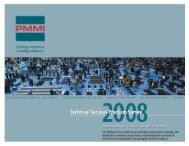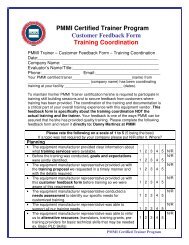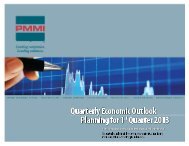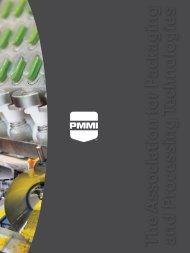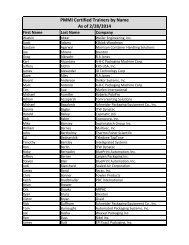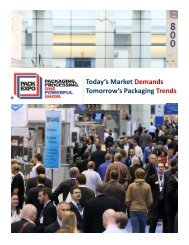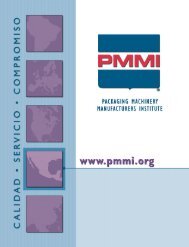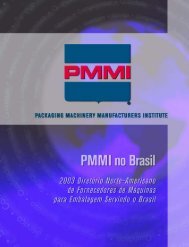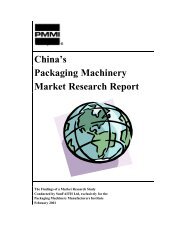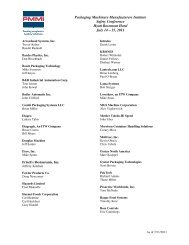Packaging Trends Report - PMMI
Packaging Trends Report - PMMI
Packaging Trends Report - PMMI
You also want an ePaper? Increase the reach of your titles
YUMPU automatically turns print PDFs into web optimized ePapers that Google loves.
P A C K A G I N G I N T E L L I G E N C E B R I E F<br />
PACKAGING TRENDS<br />
Forces that will influence packaging through the end of the decade
About the <strong>Packaging</strong><br />
Intelligence Brief Series<br />
<strong>Packaging</strong> plays a critical role in our global economy<br />
and touches the lives of everyone. For 75 years, the<br />
<strong>PMMI</strong> has been the leading global resource for packaging<br />
manufacturers to learn about industry trends, obtain<br />
training and get involved in networking events.<br />
<strong>PMMI</strong> is proud to introduce the <strong>Packaging</strong> Intelligence<br />
Brief series which focuses on trends that are shaping<br />
the future of the industry. Over the next year, <strong>PMMI</strong> will<br />
regularly release <strong>Packaging</strong> Intelligence Briefs to<br />
address various topics that are significantly impacting<br />
packaging and outlining how suppliers and manufacturers<br />
are responding to market needs.
PACKAGING TRENDS<br />
Forces will influence packaging through the end of the decade<br />
TABLE OF CONTENTS<br />
Executive Summary ....................................................................................................... 4<br />
Introduction ................................................................................................................... 4<br />
Automation..................................................................................................................... 6<br />
More Robots .................................................................................................... 7<br />
More Software and Integration .......................................................................... 8<br />
More RFID ....................................................................................................... 8<br />
Sustainability ............................................................................................................... 10<br />
Source Reduction ........................................................................................... 10<br />
Replacing Non-Renewable Resources .............................................................. 11<br />
Conserving Water and Energy ......................................................................... 12<br />
Waste Reduction ............................................................................................ 13<br />
Recycling and Recycled Content ..................................................................... 14<br />
Consumer Convenience ................................................................................................ 14<br />
Product Safety ............................................................................................................. 15<br />
Health and Wellness ..................................................................................................... 17<br />
B U I L D I N G A N E N V I R O N M E N T O F T R U S T, R E S P E C T A N D O P E N C O M M U N I C A T I O N 3
P A C K A G I N G I N T E L L I G E N C E B R I E F<br />
Executive Summary<br />
Building on familiar demands, package design and packaging<br />
lines will evolve to address the need for automation, sustainability,<br />
consumer convenience, product safety and rising consumer<br />
interest in health and wellness.<br />
Reliance on automation will increase throughout the 2008-2010<br />
time period to increase efficiency and quality and cut costs.<br />
Packagers will automate more manual operations and update<br />
and upgrade older automated operations to boost productivity,<br />
while cutting costs and labor requirements.<br />
Environmental concerns, often discussed under the banner of<br />
sustainability or climate change, have not yet peaked. As a<br />
result, between now and 2010 we’ll see continued attention on<br />
source reduction, conservation of energy, water and nonrenewable<br />
resources, minimization of greenhouse gas emissions<br />
and waste and rising levels of recycling and recycled content.<br />
Recent product introductions show how strong the demand for<br />
convenience is with products like Healthy Choice Café<br />
Steamers entrees from ConAgra Foods, Omaha, NE, in steamgenerating,<br />
cook-in packaging; Lean Cuisine panini sandwiches<br />
from Nestle USA, Glendale, CA, in microwaveable susceptor<br />
trays; organic coffee beans from Celestial Seasonings, Boulder,<br />
CO, in resealable, zippered stand-up pouches; and Pringles<br />
Minis potato crisps from Procter & Gamble Co., Cincinnati, OH,<br />
in single-serving pouches. As cook-in packaging becomes<br />
even more functional, it should remain in favor, as will package<br />
designs that are easy to open and reclose. However, the greatest<br />
action is likely to be in single-serving packs because these<br />
designs couple convenience with healthy portion control.<br />
Recalls, problems with tainted foods and drugs and the prevalence<br />
of counterfeit products worldwide are spurring packagers<br />
to scrutinize their supply chains, process controls and quality<br />
assurance practices with new intensity.<br />
With obesity seen as a major health problem in much of the<br />
developed world, skyrocketing healthcare demand and costs<br />
and the aging baby boomer population, interest in products<br />
that can improve well-being continues to rise, driving demand<br />
for better-for-you formulations, portion-control packaging,<br />
more product information, greater emphasis on fresh products<br />
and reduction in the use of artificial additives and preservatives.<br />
There also is interest in products that simplify preparation<br />
of balanced meals and improve the nutritional profile of<br />
grab-and-go foods/beverages.<br />
Although packagers may want to increase automation, and<br />
deliver products that appeal to consumers’ desire for sustainability,<br />
convenience, healthfulness, economics ultimately<br />
will determine changes are made in packaging designs<br />
and equipment.<br />
Introduction<br />
Building on familiar demands, package design and packaging<br />
lines will evolve to address the need for automation, sustainability,<br />
consumer convenience,<br />
product safety<br />
and rising consumer interest<br />
in health and wellness.<br />
The importance of sustainability,<br />
convenience, and<br />
health and wellness to<br />
today’s consumer is clearly<br />
demonstrated by products<br />
listed in the top 20 Most<br />
4
PACKAGING TRENDS<br />
Forces will influence packaging through the end of the decade<br />
Memorable New Product Launches of 2007. Sustainable products<br />
listed by consumers queried in a survey sponsored by<br />
Schneider Associates, Boston, MA; New Products magazine,<br />
Deerfield, IL; and Information Resources, Inc., Chicago, IL;<br />
include Tide 2X Ultra concentrated laundry detergent from<br />
Procter & Gamble Co., Cincinnati, OH, which contains less<br />
water and features a smaller bottle/closure than the non-concentrated<br />
formula.<br />
Food safety also is a top-of-mind concern. With high-profile<br />
U.S. recalls in 2007-2008 related to lead paint, melaminetainted<br />
petfood, C. botulinum-contaminated hot dog chili<br />
sauce, E. coli-contaminated beef and Salmonella-contaminated<br />
pot pies and peanut butter, consumers want to know<br />
what’s in a product and where it came from.<br />
Winners falling under the health and wellness and/or convenience<br />
banners include portion-controlled Hostess 100 Calorie<br />
Pack Cup Cakes from Interstate Bakeries Corp., Kansas City,<br />
MO; Alli weight loss capsules from GlaxoSmithKline, Research<br />
Triangle Park, NC; Diet Coke Plus and Coke Cherry Zero soft<br />
drinks from Coca-Cola Co., Atlanta, GA; DanActive Yogurt<br />
Drinks from Dannon Co., North Tarrytown, NY; Fresh Fit<br />
Meals from Subway Restaurants, Milford, CT; Diet Pepsi Max<br />
from PepsiCo North<br />
America, Purchase,<br />
NY; and microwaveable<br />
Oscar Meyer Deli<br />
Creations sandwiches<br />
from Kraft Foods,<br />
Northfield, IL.<br />
Product safety concerns are not limited to food or to the United<br />
States. Tainted products have been implicated in recent deaths<br />
and illnesses in China and Japan. In 2006, Cadbury<br />
Schweppes, London, UK, recalled more than 1 million chocolate<br />
bars from UK stores due to Salmonella contamination, and<br />
dozens died in Latin America after ingesting diethylene glycoltainted<br />
cough syrup.<br />
Packagers are scrutinizing their supply chains, process controls<br />
and quality assurance practices with new intensity.<br />
Although packagers may want to increase automation, and<br />
deliver products that are sustainable, convenient and healthy,<br />
economics ultimately will determine the level of investment in<br />
package design and packaging line equipment.<br />
According to Manufacturing Barometer: Business Outlook 4Q<br />
2007, a survey by PricewaterhouseCoopers, New York, NY,<br />
senior executives in U.S.-based companies are far more positive<br />
about the world economy than the U.S. economy with 64%<br />
B U I L D I N G A N E N V I R O N M E N T O F T R U S T, R E S P E C T A N D O P E N C O M M U N I C A T I O N 5
P A C K A G I N G I N T E L L I G E N C E B R I E F<br />
expressing optimism about the performance of the world economy<br />
during the next 12 months.<br />
Attitudes about the U.S. economy have slipped considerably<br />
with only 29% of those surveyed feeling optimistic about<br />
prospects for the next 12 months, a substantial decline from<br />
the 45% who felt optimistic in the third quarter of 2007 and<br />
less than half of the 64%, who were feeling positive in the<br />
fourth quarter of 2006. The top four barriers to growth cited<br />
by the executives include oil/energy prices (66%), lack of<br />
demand (61%), competition from foreign markets (44%) and<br />
monetary exchange rate (44%).<br />
Although the Federal Reserve cut interest rates to forestall<br />
or shorten a recession early in 2008, it appears likely the US<br />
economy will slow during 2008-2009, before accelerating in<br />
2009-2010. However, with the dollar low versus the Euro<br />
and other major currencies, U.S. businesses should see a<br />
rising amount of revenue derived from exports.<br />
At home, the Economic Stimulus Act of 2008, signed by<br />
President Bush in February 2008, should help offset a slowing<br />
economy through tax breaks for capital investments,<br />
especially for smaller companies planning to spend less<br />
than $800,000 in 2008.<br />
However, since the tax breaks relate primarily to equipment<br />
purchased and installed in 2008, it’s imperative to place<br />
orders early, especially for equipment with longer lead times.<br />
2007 by The Nielsen Co., New York, NY, consumers are trying<br />
to make their dollars go farther by shopping more on the<br />
internet, eating out less, staying home more, buying more<br />
store and budget brands, reducing shopping trips and shopping<br />
more at supercenters. “Manufacturers and retailers<br />
need to be alert to the fact that consumers are looking to<br />
save by altering where they shop, how they shop and what<br />
products and brands they buy,” says Todd Hale, senior vice<br />
president of Consumer Shopping & Insights at Nielsen,<br />
adding, “Value, convenience and competitive pricing will be<br />
more important than ever in the year ahead.”<br />
Higher oil prices are impacting consumers elsewhere in the<br />
world. In Europe, higher oil prices are boosting the cost of<br />
natural gas and electricity, as well as gasoline and raising<br />
fears of inflation. According to estimates from Luxembourgbased<br />
Eurostat, the annual inflation rate for the Euro area<br />
(15 member states) was 3.2% in January 2008, significantly<br />
higher than the 2% target set by the European<br />
Central Bank, Frankfurt am Main, Germany.<br />
At the global level, economic growth will slow from the<br />
4.9% registered in 2007 to 4.1% in 2008, according to<br />
projections from the International Monetary Fund,<br />
Washington, DC. Pressure on growth is coming from slowing<br />
economies in the United States, western Europe and<br />
Japan, fallout from the subprime mortgage problems in the<br />
United States and moderating growth in emerging and<br />
developing economies.<br />
For consumers, gasoline and other rising costs will put a<br />
squeeze on spending. With gas expected to hit $3.40 per<br />
gallon by mid-2008, consumers will be making increasingly<br />
tough choices between filling the tank and other purchases.<br />
According to a Nielsen Homescan Survey done in December<br />
Automation<br />
Reliance on automation will increase throughout the 2008-<br />
2010 time period to address needs to increase efficiency<br />
and quality and cut costs.<br />
6
On the packaging line, manual operations are being automated,<br />
and automated operations are looking for ways to boost<br />
productivity, while cutting costs and labor requirements. This<br />
wish list is translating into a strong interest in entry-level equipment<br />
to help packagers automate manual operations to reduce<br />
or control labor costs, improve working conditions and eliminate<br />
ergonomic hazards.<br />
PACKAGING TRENDS<br />
Forces will influence packaging through the end of the decade<br />
For operations that have already made the transition to automated<br />
equipment, the need to increase productivity and control<br />
costs is spurring demand for flexible machines that are<br />
easier to clean, change over, operate and maintain. It’s also<br />
prompting greater use of servos, networks (especially wireless),<br />
radio frequency identification (RFID) and robotics and<br />
spurring more interest in machine-to-machine and machineto-enterprise<br />
integration, use of software to collect and analyze<br />
production data, and e-machine features that permit remote<br />
access for operation, troubleshooting and/or repair.<br />
Although many packagers install new lines or upgrade existing<br />
lines to meet changing needs, there’s also a strong interest in<br />
outsourcing, especially in the food industry. According to a<br />
2007 Food <strong>Packaging</strong> <strong>Trends</strong> Study by Food Engineering magazine,<br />
32% of respondents rely on contract packagers to<br />
reduce time to market for new products, double the percentage<br />
using this strategy in 2003.<br />
More Robots<br />
Respondents to the survey classify robotics as the most noteworthy<br />
development in packaging technology, and a significant<br />
number would like to install more.<br />
Palletizing is the most common packaging application for<br />
robots, followed by case/carton packaging and pick-and-place<br />
activities. However, the units continue to add to their repertoire<br />
of packaging functions. According to a study by the <strong>PMMI</strong>,<br />
Arlington, VA, robot use has grown rapidly since 2004 with a<br />
28% jump in the number used for primary packaging and a<br />
17% increase in units performing secondary packaging tasks.<br />
Survey respondents predict palletizing will continue to dominate,<br />
but use of robots for primary packaging tasks will experience<br />
more rapid growth.<br />
With 77% of the packagers surveyed planning to use more<br />
robots, penetration on packaging lines should double from<br />
about one-fourth in 2007 to roughly one-half by 2012 with all<br />
segments participating – Food, Beverage, Chemical,<br />
Pharmaceutical/Medical, Durable Goods and Other. A growing<br />
number of these new units will be equipped with vision to<br />
reduce the need for fixturing, increase flexibility to accommodate<br />
different products and expedite changeover.<br />
The top three reasons packagers cite for adding robotics to<br />
packaging lines include reduced costs/higher efficiencies<br />
(35%), reduced labor (30%) and manufacturing flexibility<br />
(21%). Other influences include employee safety, ergonomics,<br />
speed, product quality and space constraints.<br />
B U I L D I N G A N E N V I R O N M E N T O F T R U S T, R E S P E C T A N D O P E N C O M M U N I C A T I O N 7
P A C K A G I N G I N T E L L I G E N C E B R I E F<br />
When adopting a robot, there also are hurdles to overcome.<br />
The most frequently cited by robot users surveyed include the<br />
skill level needed to operate and maintain the units, downtime,<br />
cost and the need for human intervention. However, costs are<br />
expected to drop 10-20% by 2012. In addition mean time<br />
between failures is now measured in increments approaching<br />
100,000 hours, and improved software and controls simplify<br />
setup and operation. Finally, the majority of packaging machinery<br />
companies selling robotic equipment also offer maintenance<br />
services.<br />
More Software and Integration<br />
Increasingly, the enabler on packaging lines is software. Not<br />
only does it govern machine action, but it also controls<br />
setup and interaction -- with other machines, the network<br />
and beyond to other enterprise systems and even to systems<br />
run by supply chain partners. Software also is starting<br />
to be used to measure productivity and manage performance<br />
with the goal of reducing unplanned downtime, boosting<br />
output, improving work methods and increasing maintenance<br />
efficiency.<br />
Whatever its purpose, software makes it possible to collect, store<br />
and organize packaging machine and line data and convert it into<br />
useful, retrievable and actionable information. Increasingly, this<br />
information is available remotely via a web portal.<br />
At the machine or line level, for example, the Proficy Historian<br />
tool that resides in Proficy HMI/SCADA Cimplicity visualization<br />
software from GE Fanuc Automation, Charlottesville, VA,<br />
records all process data such as temperatures, filling levels,<br />
added ingredients and raw material codes and also provides<br />
access to this information via a web-based portal. Other tools<br />
can provide real-time alerts if preset parameters are exceeded.<br />
Performance management software from companies like<br />
Informance International, Northbrook, IL, and Parsec<br />
Automation Corp., Brea, CA, monitor packaging lines, calculate<br />
overall equipment effectiveness, pinpoint problems and help<br />
identify solutions. Production data and metrics also are the<br />
focus of an Efficiency Improvement Tool, EIT 5.0, from Sidel<br />
Group, Octeville, France.<br />
More RFID<br />
RFID, a technology that automates product identification and<br />
enables item-level serialization for supply chain, track and<br />
8
PACKAGING TRENDS<br />
Forces will influence packaging through the end of the decade<br />
trace and other purposes, will continue its steady expansion<br />
due to an unwavering commitment to tagging of incoming<br />
goods by Wal-Mart Stores, Bentonville, AR, and other retailers.<br />
Other drivers include the ability to meet requirements of<br />
California’s e-pedigree law, which takes effect on 1 January<br />
2009, and its success in discouraging counterfeiting and<br />
diversion of drugs and other high-value goods.<br />
and bar codes probably will be used together, especially initially,<br />
so one can serve as a backup to the other.<br />
Some packagers have been quietly experimenting with the<br />
technology for several years. Others have been sitting on the<br />
fence. However, the heel dragging appears to be at an end<br />
since further delays in implementing the technology is going<br />
to cost suppliers to Wal-Mart and Metro AG, Düsseldorf,<br />
Germany. Both retailers plan to charge a penalty for each<br />
untagged pallet received.<br />
Meanwhile, vendors have been joining forces to provide onestop<br />
shopping for systems that include the hardware, software<br />
and systems integration needed to implement the technology<br />
to meet compliance requirements or in-house data collection<br />
needs. As is typical with virtually all electronics-based products,<br />
hardware prices are declining as functionality increases.<br />
For drug makers, 2008 will be spent preparing to meet<br />
California’s e-pedigree law. To prevent counterfeiting and diversion<br />
and simplify authentication, the California law requires<br />
marking each primary package with a unique code and reading<br />
and recording this item-level code at each step in the supply<br />
chain to create an electronic chain-of-custody record.<br />
Although the serialized code could be carried by a bar code or<br />
even manually entered, the industry seems to have narrowed<br />
its choices down to RFID or two-dimensional bar codes with<br />
RFID given an edge because a bar code has to be in the reader’s<br />
line of sight for data to be captured. However, RFID tags<br />
Drug makers relying on RFID to meet e-pedigree requirements<br />
may be able to eliminate a separate tagging operation by using<br />
source-tagged containers. At least one firm, Rexam plc,<br />
London, UK, embeds RFID tags during the injection molding<br />
process. Indicative of how close we are to large deployments of<br />
source-tagged containers is the development of a bottle<br />
inspection system to ensure the tag is viable. Positioned at the<br />
outfeed of an injection molding machine or unscrambler, the<br />
Lomax RFID system from CIVision, Aurora, IL, inspects,<br />
encodes and verifies at a rate of 240 containers per minute.<br />
Capturing item-level RFID information on the packaging line<br />
makes it possible for pharmaceutical companies to authenticate<br />
products at the filling stage. Information from sourcetagged<br />
bottles also can be used to initiate an action like labeling.<br />
At later stages in the distribution chain, RFID tags provide<br />
the opportunity to continuously gather data about a product’s<br />
travels, update its pedigree and confirm authenticity.<br />
Another indication of how far RFID technology has evolved is<br />
the availability of turnkey, plug-and-play systems that have<br />
eliminated the trial-and-error and read rate challenges that<br />
plagued early deployments of the technology. One system targeted<br />
for case and pallet coding, the self-contained, 32-tagper-minute<br />
system from Diagraph, St. Charles, MO, costs<br />
$9,500. It consists of a SATO Lt408 printer integrated with a<br />
B U I L D I N G A N E N V I R O N M E N T O F T R U S T, R E S P E C T A N D O P E N C O M M U N I C A T I O N 9
P A C K A G I N G I N T E L L I G E N C E B R I E F<br />
PA/4600 label applicator, RFID TampTenna, reject module,<br />
warning tower and stand. Unlike most systems that perform<br />
the encoding step in the print engine, Diagraph prints the label<br />
and feeds it to the patented TampTenna device, which encodes<br />
the tag, checks that the code is good, applies the label and<br />
checks the tag again as it retracts.<br />
Sustainability<br />
Environmental concerns, often discussed under the banner of<br />
sustainability or climate change, have not yet peaked. As a<br />
result, between now and 2010 we’ll see continued attention on<br />
source reduction, conservation of energy, water and nonrenewable<br />
resources, minimization of greenhouse gas emissions<br />
and waste, and rising levels of recycling and recycled content.<br />
There will be an especially high level of activity related to<br />
source reduction such as lightweighting containers and closures,<br />
eliminating secondary packaging, and replacing rigid<br />
packaging with flexible packaging. Source reduction makes an<br />
easy target because it not only consumes less material, but<br />
also helps cut energy costs throughout the supply chain by<br />
reducing shipping weight.<br />
The potential for energy savings also makes the use of<br />
materials with recycled content attractive since virgin materials<br />
require more energy to process. Thus, we’ll see slowly<br />
rising percentages of recycled content across all types of<br />
packaging materials -- glass, aluminum, steel, paper,<br />
paperboard, corrugated, plastic -- with the most significant<br />
gains in plastics like PET where efforts to increase collection<br />
rates seem likely to bear fruit.<br />
Interest in packaging materials derived from renewable<br />
resources will grow, particularly in the area of bioplastics where<br />
commercial-scale production facilities are coming online and<br />
functionality is improving.<br />
We also can expect growth in flexible packaging and aseptic<br />
products, which hold a high volume of product relative to the<br />
amount of packaging required. In addition, aseptic products<br />
offer the added benefit of reducing the need for energy-intensive<br />
refrigeration.<br />
Although packagers may be paying more attention to the environmental<br />
impact of their operations and products, the driving<br />
force behind these “green” efforts is not an altruistic “save the<br />
planet” mission, but a cost-reduction strategy. Sustainability<br />
initiatives that are not cost-effective are not sustainable and<br />
will falter and die. Finally, it should be noted that packagers<br />
need to publicize their sustainability efforts. Environmental<br />
activities that aren’t verifiably quantified and publicized don’t<br />
earn any sales from consumers or support from socially minded<br />
investors.<br />
Source Reduction<br />
One of the most frequently employed tactics to shrink a product’s<br />
environmental footprint is source reduction. Generally<br />
accomplished by lightweighting or downgauging, source<br />
reduction involves using less material in the first place. As a<br />
result, it almost always helps packagers cut costs or offset<br />
price increases.<br />
A host of source-reduced products are coming on the market<br />
including lightweighted PET containers, short-skirt closures,<br />
and dispensers from Nordson Corp., Duluth, GA, that<br />
foam adhesive or apply it in an intermittent rather than continuous<br />
bead.<br />
10
PACKAGING TRENDS<br />
Forces will influence packaging through the end of the decade<br />
Nestlé Waters North America,<br />
Greenwich, CT, for example, relies<br />
on Sidel’s Flex technology to<br />
produce its lightweight Eco-<br />
Shape bottle. Weighing in at<br />
12.5 grams, about 30% less<br />
than the average half-litre<br />
(16.9-ounce) PET water bottle,<br />
the Eco-Shape container is<br />
commercial for the Arrowhead,<br />
Ozarka and Poland Springs<br />
brands and eventually will be<br />
used throughout the Nestle<br />
Waters North America system.<br />
Short-skirt closures typically reduce total container weight by<br />
a gram or two. Not only does the closure itself weigh less, but<br />
the designs reduce the amount of resin needed in the finish<br />
area of the container. A number of closure makers have<br />
added shirt-skirt options to their product lines including<br />
Rank Group’s Closure Systems International (formerly Alcoa<br />
CSI), Indianapolis, IN, with the Xtra-Lok mini for carbonated<br />
soft drinks and the MB-Lok mini for malt beverages;<br />
SuperShorty closures from Bericap GmbH and Co. KG,<br />
Budenheim, Germany; the PCO closure<br />
from Corvaglia, Eschlikon,<br />
Switzerland; and designs from the<br />
Obrist division of Global Closure<br />
Systems, Paris, France.<br />
When multiplied by millions of containers and closures, even<br />
small weight reductions add up to a significant amount of resin<br />
and can help control or even reduce packaging and distribution<br />
costs. In addition, if the lighter weight results in a denser<br />
cube, it also can generate savings in distribution packaging<br />
and shipping and handling costs due to more efficient transportation<br />
utilization and reduced handling.<br />
Replacing Non-Renewable Resources<br />
Most packaging is made from nonrenewable resources.<br />
Although some metal, glass and plastic packaging is recycled<br />
and more could be recycled, packaging derived from<br />
renewable resources like wood fiber or corn is viewed by<br />
many as more environmentally friendly. Bioplastics are seen<br />
as especially appealing because they offer a way to reduce<br />
reliance on oil.<br />
However, it should be noted that definitions of terms like bioplastic<br />
and biopolymer are not standardized and may describe<br />
materials that are not biodegradable, compostable or 100%<br />
derived from renewable resources. As a result, it’s necessary<br />
for a packager to carefully define its requirements and verify<br />
the renewable packaging being purchased meets or exceeds<br />
specifications. U.S standards like ASTM D6400 for compostable<br />
plastics and ASTM D6868 for compostable packaging,<br />
European standards like EN13432 for biodegradability/compostability<br />
and certification systems established by the<br />
B U I L D I N G A N E N V I R O N M E N T O F T R U S T, R E S P E C T A N D O P E N C O M M U N I C A T I O N 1 1
P A C K A G I N G I N T E L L I G E N C E B R I E F<br />
Biodegradable Products Institute, New York, NY, can help<br />
ensure the packaging purchased performs as expected.<br />
Although the concept of compostable and/or biodegradable<br />
films is appealing, it should be noted that at present very little<br />
of the material will actually be composted. A widespread<br />
composting infrastructure simply doesn’t exist in the United<br />
States. In Europe, the European Union’s Landfill Directive<br />
restricts landfilling of biodegradable waste. As a result, some<br />
countries have a well-established composting infrastructure,<br />
others do not. In Japan, a Food Recycling Law passed in<br />
2001 has had a positive effect on the availability of composting<br />
facilities and rates.<br />
There also are several certification systems for fiber used in<br />
paper, paperboard and corrugated. Programs like the<br />
Sustainable Forestry Initiative, Inc., Arlington, VA, or Forest<br />
Stewardship Council – U.S., Reston, VA, for example, confirm<br />
fiber comes from sustainably managed sources.<br />
Packagers have a growing number of bioplastic options to<br />
choose from for both rigid and flexible packaging. Functionality<br />
is rapidly evolving too. In addition, there’s a continuous effort to<br />
improve the environmental profile of bioplastics. Recent developments<br />
include the production of conventional polyethylene<br />
from ethanol derived from sugar cane. Work also is proceeding<br />
on producing bioplastics from food waste or waste agricultural<br />
material such as bagasse (residue from sugar cane processing)<br />
rather than using food crops like corn.<br />
As interest in packaging from renewable sources has grown,<br />
visual carded packaging, long the province of plastic<br />
clamshells, is seeing a shift toward designs with a higher level<br />
of fiber content, recycled content and/or bioplastics. Suppliers<br />
of what’s described as environmentally friendly visual carded<br />
packaging like Colbert <strong>Packaging</strong> Corp., Lake Forest, IL; Dot<br />
<strong>Packaging</strong> Group, Inc., Batavia, IL; or CardPak, Inc., Solon, OH;<br />
also control or eliminate emissions of volatile organic compounds<br />
from coatings and ink and work with customers to finetune<br />
designs for optimum cube.<br />
Conserving Water and Energy<br />
With energy costs rising, water increasingly viewed as a finite<br />
resource and socially aware investors asking hard questions<br />
about impact on the environment, packagers are paying more<br />
attention to energy and water conservation measures.<br />
Many companies are working to reduce water consumption.<br />
Since 2002, breweries operated by Anheuser-Busch<br />
Companies, Inc. (A-B), St. Louis, MO, have reduced water consumption<br />
5%, a savings of about 875 million gallons.<br />
12
PACKAGING TRENDS<br />
Forces will influence packaging through the end of the decade<br />
Food and beverage companies also are converting to non-traditional<br />
power generation options. Kraft Foods, Northfield, IL,<br />
for example, provides some power for one of its plants via<br />
methane generated by adding bacteria to whey, a byproduct of<br />
cream cheese production.<br />
A-B ranks as the world’s largest user of Bio-Energy Recovery<br />
Systems. Installed at nine out of 12 of the company’s U.S.<br />
breweries and at its facility in Wuhan, China, the system captures<br />
biogas from brewery wastewater and burns it to supply<br />
up to 15% of a location’s energy needs. In 2007, biogasderived<br />
energy supplied A-B with heat equal to that needed for<br />
25,000 homes and reduced greenhouse gas emissions by 258<br />
million pounds.<br />
In England, Scottish & Newcastle plc, Edinburgh, Scotland,<br />
plans to install two biomass-fueled heat/power plants built<br />
by Wärtsilä, Helsinki, Finland, at breweries in Manchester.<br />
<strong>Report</strong>edly the first units in the world to produce both electricity<br />
and heat using spent grain, a brewing byproduct, as<br />
fuel, the plants will burn a mixture of spent grain and wood<br />
chips from local sources, and will begin producing steam<br />
and electricity for the breweries in 2009. Excess electricity<br />
will be exported to the local grid. “The Wärtsilä BioPower<br />
plants will enable Scottish & Newcastle to make more efficient<br />
use of residue from its beer production, cut down on<br />
waste handling and energy costs, as well as reducing carbon<br />
dioxide emissions,” reports Tauno Kuitunen, regional sales<br />
director for Wärtsilä Biopower.<br />
Welch’s, Concord, MA, is experimenting with a hydrogen-fromwaste<br />
extraction technology developed by NanoLogix, Inc.,<br />
Hubbard, OH, to generate electricity from juice waste. The plant<br />
near Erie, PA, takes water used to clean juice storage tanks and<br />
adds microbes to consume the sugar from the juice. Hydrogen<br />
generated by the microbes is captured in tanks for use as an<br />
energy source. With the concept proven on a pilot-plant scale,<br />
Welch’s plans to build a large-scale bioreactor in Erie this<br />
spring, according to a report by Lisa Ann Pinkerton on Allegheny<br />
Front, an environmental radio station based in Pittsburgh, PA. If<br />
successful, the full-scale system could mean a substantial<br />
reduction in the $1 million the plant spends each year on electricity<br />
and wastewater treatment (about $500,000 each).<br />
Some packagers have turned to solar energy or wind power<br />
or purchase offsets to improve their carbon footprint. In<br />
Portland, OR, Lucky Labrador Brewing Co. has installed a<br />
solar hot water system to heat the water needed for the first<br />
stage of the process for brewing its Sun Beer. Other craft<br />
breweries like Anderson Valley Brewing Co., Boonville, CA,<br />
power their plants with arrays of photovoltaic panels that<br />
convert sunlight to electricity.<br />
In many cases, tax credits are available for installing this type<br />
of “green” improvement.<br />
Improving distribution efficiency to reduce the number of<br />
trucks and miles driven is another popular tactic. A growing<br />
number of software programs are available to plan the most<br />
efficient routes.<br />
Waste Reduction<br />
Despite a couple decades of effort to reduce packaging<br />
waste, particularly in Europe, it remains an issue and appears<br />
to be a growing concern. In global Environmental Concerns<br />
surveys done by Nielsen in May 2007 and November 2007,<br />
the number of consumers who said they were “very” concerned<br />
about packaging waste increased from 31% to 40%.<br />
In addition, in the November 2007 survey, the concern about<br />
B U I L D I N G A N E N V I R O N M E N T O F T R U S T, R E S P E C T A N D O P E N C O M M U N I C A T I O N 1 3
P A C K A G I N G I N T E L L I G E N C E B R I E F<br />
packaging waste increased more than any other, outpacing<br />
worries about climate change, water shortage, water and air<br />
pollution and use of pesticides.<br />
With more than one-third of the population very concerned<br />
about packaging waste, it’s time to be proactive about reducing,<br />
reusing and recycling.<br />
Recycling and Recycled Content<br />
Recycled content is commonly found in all types of packaging.<br />
Replacing virgin content with recycled saves energy, reduces<br />
waste and cuts greenhouse gas emissions. In most cases, higher<br />
percentages of recycled content could be used, but demand<br />
for recycled materials exceeds supply.<br />
That’s why Coca-Cola and other companies are working to<br />
boost collection and recycling rates. In fact Coca-Cola recently<br />
committed to recycling 100% of the aluminum bevcans and<br />
PET containers it uses. The company also supports recycling<br />
programs and has invested in a PET recycling plant operated<br />
by United Resource Recovery Corp., Spartanburg, SC, to provide<br />
food-grade recycled PET (RPET) for its containers.<br />
Although Coca-Cola probably won’t use 100% RPET bottles<br />
before the end of the decade, it is technically feasible to do<br />
so, a feat once thought to be impossible. At least two companies<br />
have commercial products on the market in 100%<br />
RPET containers. Innocent Ltd., London, UK, uses a 250-millilitre<br />
(ml) 100% RPET bottle for its ready-to-drink, refrigerated<br />
smoothies, and GlaxoSmithKline, Brentford, UK, specifies<br />
a 500ml RPET bottle for its Ribena fruit drinks.<br />
On the packaging line, switching from a virgin PET to an RPET<br />
container should require few, if any, adjustments. However,<br />
injection molding or sheet/film extrusion may necessitate<br />
additives to improve processability and properties as well as<br />
special drying and filtration equipment. Even then, the RPET<br />
packaging may exhibit slightly diminished physical properties<br />
like intrinsic viscosity, tensile strength, light transmission,<br />
haze and clarity. It also should be noted that widespread use<br />
of 100% RPET packaging will require substantially a higher<br />
collection and recycling rate for PET containers than the<br />
23.5% achieved in the United States in 2006 (the most recent<br />
year statistics are available).<br />
Consumer Convenience<br />
Although the Nielsen Global Food <strong>Packaging</strong> Survey indicates<br />
nearly half of the respondents are willing to give up<br />
convenience packaging to benefit the environment, one<br />
wonders if these good intentions are actually carried at the<br />
cash register in the mad dash to put a meal on the table<br />
before Susie’s 7 p.m. soccer game.<br />
14
PACKAGING TRENDS<br />
Forces will influence packaging through the end of the decade<br />
Food processors queried by Food Engineering magazine,<br />
Bensenville, IL, in its 2007 Food <strong>Packaging</strong> <strong>Trends</strong> Survey,<br />
believe convenience rules, ranking third behind product<br />
shelf life and food safety as the force with the greatest<br />
impact on their business.<br />
Certainly, recent product introductions address consumer<br />
demand for convenience with newcomers like Healthy Choice<br />
Café Steamers entrees from ConAgra Foods, Omaha, NE, in<br />
steam-generating, cook-in packaging; Lean Cuisine panini<br />
sandwiches from Nestle USA, Glendale, CA, in microwaveable<br />
susceptor trays; organic coffee beans from Celestial<br />
Seasonings, Boulder, CO, in resealable, zippered stand-up<br />
pouches; and Pringles Minis potato crisps from Procter &<br />
Gamble Co., Cincinnati, OH, in single-serving pouches. In fact,<br />
many of these popular products have the same features, the<br />
respondents in the Nielsen survey said they were willing to give<br />
up -- packaging designed for easy stacking/storing at home<br />
(49%), packaging that can be used for cooking or doubles as a<br />
resealable container (48%) and packaging designed for easy<br />
transport (47%).<br />
Largely ignored when package designers think of convenience<br />
is senior-friendliness. Although few design changes are likely to<br />
occur before the end of the decade, aging baby boomers and<br />
a rapidly growing over-80 population guarantee more attention<br />
post-2010 to senior-friendly features like larger type for critical<br />
information like best-by dates, and easier-to-manipulate opening/reclosure<br />
mechanisms.<br />
With Braille required on<br />
European drug packaging,<br />
it seems likely its<br />
use will become universal<br />
on drug packaging<br />
and spread to other<br />
product segments.<br />
Product Safety<br />
A seemingly endless succession of food recalls, a significant<br />
level of counterfeiting worldwide, pedigree rules looming for<br />
pharmaceuticals and the possibility of terrorist attack by<br />
tainted consumer product have left consumers uneasy and<br />
consumer packaged goods companies trying to identify and<br />
mitigate risks.<br />
In fact, food safety tops the list of concerns cited by food<br />
processors when asked what factors influence new package<br />
development in a survey done in 2007 by Food<br />
Engineering magazine.<br />
B U I L D I N G A N E N V I R O N M E N T O F T R U S T, R E S P E C T A N D O P E N C O M M U N I C A T I O N 1 5
P A C K A G I N G I N T E L L I G E N C E B R I E F<br />
As a result, packagers will institute more stringent requirements<br />
for suppliers of packaging equipment, materials, containers and<br />
other components. Suppliers will be expected to certify they are<br />
shipping the highest quality product and demonstrate that they<br />
have effective measures in place to ensure their incoming<br />
goods are clean and contaminant-free and that their process<br />
prevents introduction of any contaminants.<br />
Heightened concern about product safety will prompt<br />
increased use of track-and-trace technologies like serialized<br />
bar coding and RFID. It also will encourage adoption of anticounterfeiting<br />
tools like holographic labels, micro-printing and<br />
taggant-equipped packaging.<br />
On the packaging line, greater attention will be paid to<br />
washdown compatibility and hygienic design, which eliminates<br />
areas that could collect dirt or product residue, as<br />
well as features like automated clean-in-place and easy<br />
assemble/disassemble product contact change parts.<br />
Cleanliness-enhancing design/components not only help<br />
protect product quality, but also minimize man hours needed<br />
for line changeover and cleanup.<br />
Control systems will be upgraded to enable proactive identification<br />
and prevention of operational glitches that could<br />
result in problems like under-processing.<br />
16
Packagers will install more quality-control equipment like X-<br />
ray inspectors, metal detectors, near-infrared inspection<br />
systems and vision systems to help minimize the chance of<br />
faulty product slipping through and entering the supply<br />
chain. There also will be increased use of rapid detection<br />
systems for contaminants like Listeria and E. coli.<br />
PACKAGING TRENDS<br />
Forces will influence packaging through the end of the decade<br />
Fortunately, the latest quality control equipment brings<br />
increased functionality at a lower price. One example of the<br />
expanded capabilities available today is the IQ3+ variable<br />
frequency metal detector from Loma Systems, Inc., Carol<br />
Stream, IL. It can be set at any frequency between 30 and<br />
900 kilohertz to match the frequency of the product, overcoming<br />
the limitations experienced with standard metal<br />
detectors that operate on no more than three frequencies<br />
and therefore may miss smaller pieces of metal or be<br />
unable to inspect products in metallized packaging.<br />
Similarly, the patent-pending ScanTrac DUO x-ray inspection<br />
system from InspX LLC, Fremont, CA, uses two x-ray<br />
beams instead of one to improve its ability to detect foreign<br />
material contaminants, underfills and packaging imperfections<br />
in glass bottles and jars. Dual views and advanced<br />
image processing software increase accuracy, identify<br />
smaller contaminants and reduce false-reject rates to less<br />
than 1 in 10,000 at conveyor speeds of 700 feet or 1,400<br />
containers/minute.<br />
Concerns about food safety and the increased emphasis on<br />
fresh food will prompt greater use of labels and tags that<br />
provide a visual indicator of freshness and purity. Time-temperature<br />
indicator labels, which have been available for<br />
approximately two decades, change color as time passes<br />
and when storage temperature parameters are exceeded.<br />
Newer options include RFID tags capable of monitoring temperatures,<br />
and labels that detect the presence of spoilage<br />
organisms or pathogens. “Consumers are willing to pay<br />
more for packaging which guarantees freshness,” notes a<br />
survey about packaging trends by Datamonitor, London, UK.<br />
Health and Wellness<br />
With obesity seen as a major health problem in much of the<br />
developed world, skyrocketing healthcare demand and costs<br />
and the aging baby boomer population, interest in products<br />
that can improve well-being continues to rise.<br />
B U I L D I N G A N E N V I R O N M E N T O F T R U S T, R E S P E C T A N D O P E N C O M M U N I C A T I O N 1 7
P A C K A G I N G I N T E L L I G E N C E B R I E F<br />
As a result, the marketplace is seeing more products with<br />
lower salt, fat and sugar levels, more single-serving, portion-controlled<br />
packs, demand for more product information,<br />
greater emphasis on fresh products and reduction in<br />
the use of artificial additives and preservatives.<br />
In addition to limiting salt, fat, sugar, calories, preservatives<br />
and/or artificial ingredients, food and beverage makers are<br />
introducing more functional products like pre- and probiotics<br />
and developing offerings that simplify preparation of balanced<br />
meals and improve the nutritional profile of graband-go<br />
foods/beverages.<br />
Reduction in ingredients with preservative qualities may<br />
necessitate conversion to packaging with higher barrier<br />
properties such as barrier laminations and coextrusions,<br />
metallized or foil-based structures and “smart” packages<br />
with an active component like an oxygen scavenger. On fillseal<br />
and form-fill-seal machines, changes in flexible packaging<br />
materials may require adjustments in dwell time and<br />
sealing, as well as a shift to more sophisticated quality<br />
control equipment like metal detectors and leak testers.<br />
According to data from IRI, sales of 100-calorie snacks<br />
grew 56% between November 2006 and November 2007.<br />
Since many single-serving products rely on pouch packaging,<br />
food processors will need to increase capacity by<br />
adding vertical form-fill-seal machines and flow wrappers.<br />
Food processors also are likely to install more thermoformfill-seal<br />
units to package products like single-serving<br />
applesauce, stick pack machines for dry mixes and liquid<br />
fillers capable of handling small bottles.<br />
Many products also are prominently listing calorie counts<br />
on labels. Campbell Soup Co., Camden, NJ, for example,<br />
which has offered Soup at Hand in single-serving<br />
microwaveable cups for several years, now flags calorie<br />
content on Soup at Hand varieties with 100 calories or less.<br />
It also has added calorie count violators to labels on cans of<br />
its lower calorie Campbell’s Select and red label soups.<br />
Today’s consumer wants more nutritional information.<br />
“Health and wellness are major forces in today’s marketplace<br />
and are having a significant impact on consumer purchase<br />
behavior in most food and beverage categories…,”<br />
reports Tatjana Meerman of Packaged Facts, Rockville, MD,<br />
publisher of studies like Market Trend: Low, Reduced or No<br />
Sodium or Salt Foods and Beverages in the U.S.<br />
As a result, there has been a proliferation of single-portion<br />
snacks and side dishes in small pouches or rigid containers.<br />
Portion control is definitely something consumers want.<br />
The demand for more nutritional information has prompted<br />
several companies to emphasize certain details on their<br />
packaging. For example, Kellogg Co., Battle Creek, has<br />
added Nutrition at a Glance banners to the front panels of<br />
18
cartons of its ready-to-eat cereal. The banners feature<br />
information about calorie, fat, sugar and sodium content<br />
and also state whether the cereal inside contains more than<br />
10% of an adult’s recommended daily allowance of fiber,<br />
magnesium, calcium, potassium and vitamins A, C or E.<br />
PACKAGING TRENDS<br />
Forces will influence packaging through the end of the decade<br />
ConAgra Foods, Inc., Omaha, NE,<br />
has added a nutrition guide on<br />
packaging for products in its<br />
Healthy Choice, Chef Boyardee and<br />
Orville Redenbacher’s lines. Based<br />
on MyPyramid recommendations from the U.S. Department<br />
of Agriculture (USDA), Washington, DC, the label shows the<br />
amount of each key food group contained in each package,<br />
making it easier for consumers to build more healthful<br />
diets. For example, a Healthy Choice Fiesta Chicken meal<br />
that contains chicken, rice, fruit and vegetables includes a<br />
graphic indicating the product provides 15% of the grains,<br />
30% of the vegetables, 15% of the fruit and 40% of the<br />
meat and beans that a consumer should eat per day based<br />
on a 2,000-calorie diet. The new labeling complements<br />
ConAgra’s Start Making Choices program, which provides<br />
consumers with advice on living a balanced life. Information<br />
from the product packaging can be used in program tools<br />
like the Balanced Life Index to help consumers make choices<br />
that help achieve their health goals.<br />
With so many different formats, this deluge of nutritional<br />
information could become more confusing than useful to<br />
consumers, sparking calls for standardization and raising<br />
the specter of regulatory action.<br />
B U I L D I N G A N E N V I R O N M E N T O F T R U S T, R E S P E C T A N D O P E N C O M M U N I C A T I O N 1 9
About <strong>PMMI</strong><br />
<strong>PMMI</strong> is a trade association with more than 540 member companies that manufacture packaging and packaging-related<br />
converting machinery, commercially-available packaging machinery components, containers and<br />
materials in the United States and Canada. <strong>PMMI</strong>'s vision is to be the leading global resource for packaging,<br />
and its mission is to improve and promote members' abilities to meet the needs of their customers. Learn<br />
more about <strong>PMMI</strong> at pmmi.org.<br />
<strong>PMMI</strong> Total Access<br />
Comprehensive packaging resources. One trusted source.<br />
Whether you’re looking to understand packaging trends, solve pressing issues or identify specific supplier<br />
solutions, <strong>PMMI</strong> Total Access gives you the resources you need.<br />
• PACK EXPO – The only tradeshow to see the latest packaging innovations while interacting with suppliers<br />
and networking with your peers.<br />
Join more than 45,000 people from 125-plus countries at PACK EXPO International November 9-13,<br />
2008 at McCormick Place in Chicago, IL.<br />
• packexpo.com – The only packaging web site that connects buyers and sellers with personalized content<br />
to help you make more informed business decisions.<br />
Use targeted search capabilities to find the packaging information you need. Keep track of suppliers<br />
and products while networking with peers 24/7.<br />
• PMT Magazine – The industry’s only publication dedicated to professionals in packaging operations,<br />
purchasing, maintenance and training.<br />
Leverage the most in-depth, forward-thinking packaging and manufacturing information – from technological<br />
advances to industry trends – in print, online and in person.<br />
Connect to the entire packaging supply chain today with <strong>PMMI</strong> Total Access.<br />
For more information about <strong>PMMI</strong> Total Access, contact <strong>PMMI</strong> at 703-243-8555 or visit pmmi.org and<br />
www.packexpo.com



